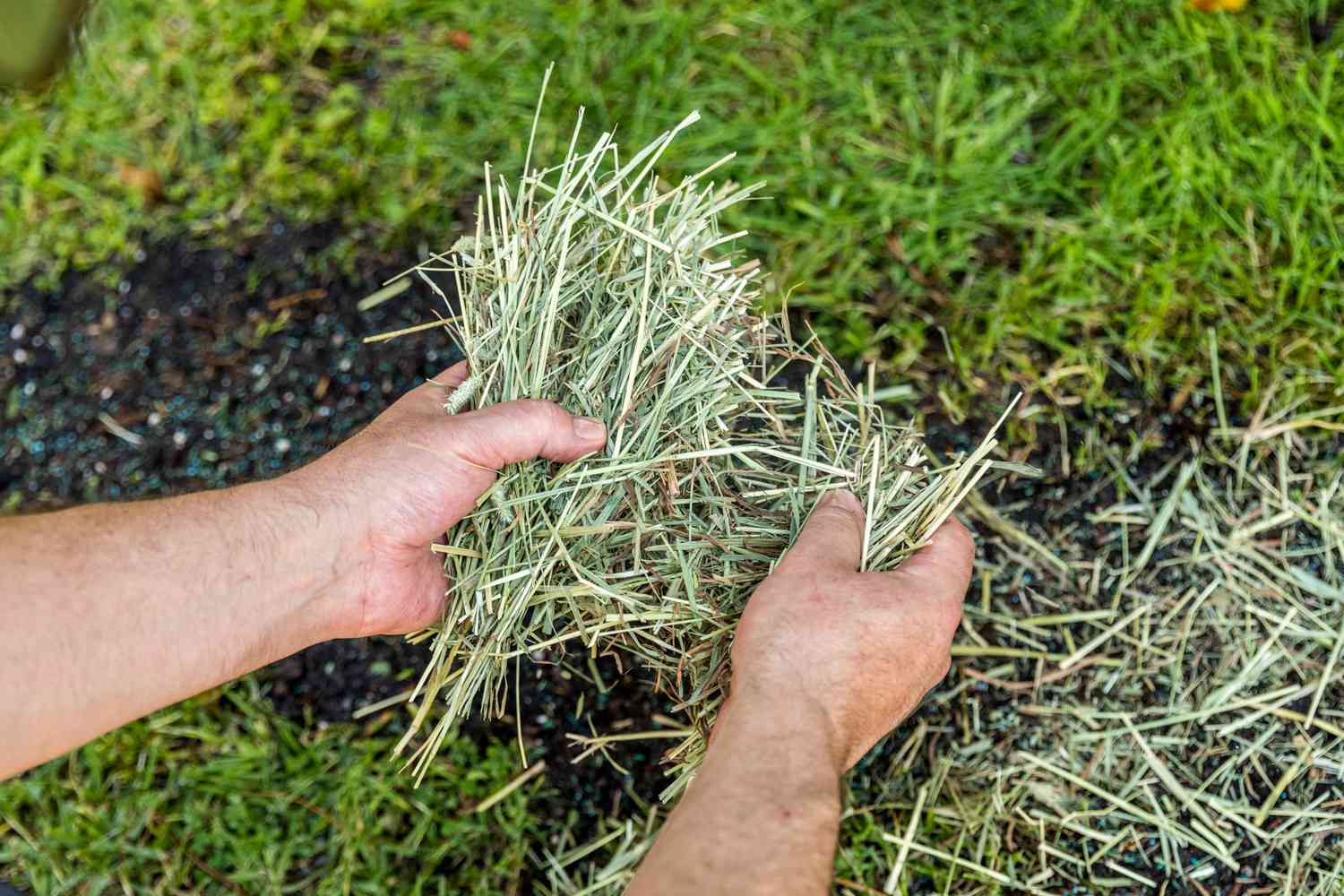Home>Home and Garden>How To Stripe Grass


Home and Garden
How To Stripe Grass
Published: March 2, 2024
Learn the best techniques for striping your grass to achieve a professional look in your home and garden. Discover step-by-step instructions and expert tips.
(Many of the links in this article redirect to a specific reviewed product. Your purchase of these products through affiliate links helps to generate commission for Noodls.com, at no extra cost. Learn more)
Table of Contents
Introduction
Creating beautifully striped grass is a simple yet effective way to enhance the visual appeal of your lawn. The process of striping grass involves mowing the grass in different directions to create alternating light and dark stripes, resulting in a stunning and professional-looking lawn. Whether you're a homeowner looking to elevate your curb appeal or a landscaping enthusiast aiming to achieve a picture-perfect lawn, mastering the art of grass striping can transform your outdoor space into a work of art.
Striping your grass not only adds aesthetic value but also contributes to the overall health of your lawn. By mowing in specific patterns, you can encourage the grass to grow more upright and evenly, promoting a lush and vibrant appearance. Additionally, the alternating light and dark stripes can create the illusion of depth and texture, making your lawn appear more expansive and well-manicured.
In this comprehensive guide, we will delve into the step-by-step process of striping grass, covering everything from selecting the right grass type to maintaining your stripes for long-lasting visual impact. Whether you're a novice or an experienced gardener, this guide will equip you with the knowledge and techniques needed to achieve professional-looking stripes on your lawn.
So, let's roll up our sleeves and embark on this journey to transform your lawn into a captivating canvas of vibrant, striped grass. With the right tools, techniques, and a touch of creativity, you'll soon be on your way to creating a stunning outdoor space that will be the envy of your neighborhood.
Read more: How To Remove Grass Stains
Step 1: Choose the Right Grass Type
Selecting the right grass type is the foundational step in achieving beautifully striped grass. Different grass species have varying characteristics, including blade width, growth pattern, and color, all of which can significantly impact the visual outcome of your lawn stripes. When choosing a grass type for striping, consider factors such as climate, soil type, and maintenance preferences to ensure optimal results.
For cool-season regions, grass species such as Kentucky bluegrass and fine fescue are popular choices due to their ability to thrive in cooler temperatures. These grasses have fine blades and a dense growth habit, making them ideal for creating defined and uniform stripes. On the other hand, warm-season grasses like Bermuda grass and Zoysia grass are well-suited for regions with hot summers, offering a lush and vibrant canvas for creating striking lawn patterns.
In addition to climate considerations, it's essential to assess the level of maintenance you're willing to commit to. Some grass types, such as perennial ryegrass, are known for their quick germination and establishment, making them suitable for temporary lawn striping projects. Conversely, if you prefer a low-maintenance lawn with minimal mowing requirements, consider grass varieties with slower growth rates and lower water needs, such as tall fescue or buffalo grass.
Furthermore, the color and texture of the grass blades play a crucial role in enhancing the visual impact of lawn stripes. Opt for grass species with rich green hues and fine, uniform blades to achieve sharp and defined stripes. Additionally, consider the overall aesthetic you wish to create, whether it's a formal, manicured look or a more natural, textured appearance.
By carefully selecting the right grass type based on your region's climate, maintenance preferences, and visual goals, you can lay a solid foundation for creating stunning lawn stripes that will elevate the beauty of your outdoor space. With the perfect grass type in place, you're ready to move on to the next steps in the process of achieving professional-looking lawn stripes.
Step 2: Prepare Your Lawn
Before diving into the process of striping your grass, it's crucial to prepare your lawn adequately to ensure optimal results. Proper lawn preparation sets the stage for seamless mowing and enhances the overall visual impact of the stripes. Here's a detailed breakdown of the essential steps to prepare your lawn for the striping process:
Clear the Lawn
Begin by clearing the lawn of any debris, such as fallen branches, rocks, or children's toys, that may obstruct the mowing path. Clearing the lawn not only ensures a smooth mowing experience but also minimizes the risk of potential damage to the lawn mower or the grass blades.
Mow the Grass
Before creating the stripes, mow the grass to an appropriate height based on the grass type and the season. It's recommended to set the mower deck at a slightly higher level to leave the grass slightly longer, as longer grass blades are more flexible and responsive to the striping pattern. Additionally, ensure that the lawn is free of any uneven patches or overgrown areas to facilitate a uniform mowing process.
Define the Edges
Neatly define the edges of the lawn using a string trimmer or lawn edger to create clean borders. Well-defined edges provide a polished look to the lawn and serve as a visual frame for the striped pattern, enhancing the overall aesthetic appeal.
Check the Soil Moisture
Assess the moisture level of the soil before proceeding with the striping process. Ideally, the soil should be moderately moist but not overly wet to prevent the grass blades from clumping together during mowing. If the soil is excessively dry, consider watering the lawn a day or two before mowing to achieve optimal mowing conditions.
Inspect the Lawn Mower
Ensure that the lawn mower is in prime condition for the striping process. Check the mower blades for sharpness and alignment, as dull or misaligned blades can result in uneven cuts and diminish the clarity of the stripes. Additionally, confirm that the mower's tire pressure is adequate to maintain consistent contact with the ground for uniform mowing.
By meticulously preparing your lawn through these essential steps, you'll create an ideal canvas for crafting stunning grass stripes. With the groundwork laid and the stage set, you're now ready to delve into the intricacies of selecting the right lawn mower and planning the perfect striping pattern to transform your lawn into a captivating display of alternating light and dark stripes.
Step 3: Select the Right Lawn Mower
Choosing the right lawn mower is a pivotal aspect of achieving impeccable grass stripes. The type of lawn mower you select can significantly influence the precision, clarity, and overall visual impact of the stripes on your lawn. When it comes to creating professional-looking patterns, several key factors should be considered in the selection of the ideal lawn mower.
Consider the Mower's Cutting Deck Width
The cutting deck width of the lawn mower plays a crucial role in determining the width and definition of the lawn stripes. Opt for a mower with a wider cutting deck to create broader and more pronounced stripes. A wider cutting deck allows for greater coverage with each pass, resulting in more defined and visually striking patterns. Additionally, a wider cutting deck reduces the number of passes required to mow the entire lawn, saving time and effort while ensuring consistent stripe width throughout the lawn.
Evaluate the Mower's Roller or Striping Attachment
Many modern lawn mowers are equipped with rollers or striping attachments specifically designed to enhance the striping effect on grass. These components create the contrasting light and dark stripes by bending the grass blades in different directions as they are mowed. When selecting a lawn mower for striping, consider models that feature heavy-duty rollers or striping attachments, as these elements contribute to the creation of sharp, long-lasting stripes with a professional finish.
Assess the Mower's Maneuverability and Control
Efficient maneuverability and precise control are essential for executing intricate striping patterns with ease. Look for a lawn mower that offers excellent maneuverability, allowing you to navigate around obstacles and make smooth turns without disrupting the stripe formation. Additionally, features such as adjustable cutting heights and responsive steering mechanisms contribute to the mower's control, enabling you to achieve seamless transitions between mowing directions and create visually captivating patterns with precision.
Prioritize Quality and Maintenance
Investing in a high-quality lawn mower with durable construction and reliable performance is essential for long-term striping success. Choose a mower from a reputable brand known for producing reliable and well-built equipment. Additionally, consider the maintenance requirements of the mower, including blade sharpening, oil changes, and overall upkeep. A well-maintained mower ensures consistent cutting performance, contributing to the clarity and longevity of the lawn stripes.
By carefully considering these factors and selecting a lawn mower that aligns with the specific requirements of your lawn and striping goals, you can set the stage for achieving professional-grade grass stripes that enhance the visual appeal of your outdoor space. With the right lawn mower in your arsenal, you're poised to embark on the next steps of planning and executing the perfect striping pattern to transform your lawn into a captivating canvas of alternating light and dark stripes.
Step 4: Plan Your Stripes
Planning your lawn stripes is a crucial step that sets the stage for creating visually stunning patterns that complement your outdoor landscape. By strategically mapping out the direction and layout of your stripes, you can achieve a professional and polished look that enhances the overall aesthetic appeal of your lawn. Here's a detailed breakdown of the key considerations and techniques involved in planning your grass stripes:
Assess Your Lawn's Layout
Begin by evaluating the layout and features of your lawn, including any existing landscaping elements, such as flower beds, trees, or pathways. Take note of any obstacles or irregularities that may influence the direction and continuity of your stripes. Understanding the layout of your lawn allows you to adapt your striping plan to seamlessly integrate with the existing landscape, creating a harmonious and visually appealing result.
Choose a Striping Pattern
Selecting a striping pattern is where creativity meets practicality. Popular patterns include the classic single-pass stripes, chevron patterns, checkerboard designs, and radial patterns. Each pattern offers a unique visual impact, and the choice often depends on personal preference and the overall aesthetic you wish to achieve. Consider the size and shape of your lawn, as well as any focal points or viewing angles that can be accentuated by specific striping patterns.
Account for Sunlight and Viewing Angles
Take into account the direction of sunlight and the primary viewing angles of your lawn. The interplay of light and shadow significantly enhances the visibility of lawn stripes. By aligning your striping pattern with the natural sunlight and prominent viewing angles, you can create dynamic and eye-catching patterns that showcase the depth and texture of the grass, elevating the overall visual impact.
Incorporate Straight Lines and Curves
Integrating straight lines and gentle curves into your striping plan adds dimension and visual interest to the lawn. Straight lines create a sense of structure and formality, while curves introduce a fluid and organic feel. Combining both elements can result in a balanced and captivating design that complements the contours of your lawn, creating a cohesive and visually appealing striped pattern.
Experiment with Test Stripes
Before committing to a specific striping pattern, consider creating test stripes in a small, inconspicuous area of your lawn. This allows you to experiment with different mowing directions and patterns to gauge the visual impact and determine the most effective design for your lawn. Testing different patterns also provides an opportunity to fine-tune your technique and ensure a seamless execution of the chosen striping pattern across the entire lawn.
By meticulously planning your grass stripes and considering the layout, patterns, sunlight, and test runs, you can set the stage for creating captivating and professional-grade lawn stripes that elevate the visual appeal of your outdoor space. With a well-thought-out striping plan in place, you're ready to bring your vision to life and transform your lawn into a stunning canvas of alternating light and dark stripes.
Step 5: Mow Your Lawn
With meticulous preparation and a well-thought-out striping plan in place, it's time to bring your vision to life by mowing your lawn to create stunning grass stripes. The mowing process is where your careful planning and attention to detail culminate in the transformation of your outdoor space into a captivating canvas of alternating light and dark stripes.
Begin by positioning the lawn mower at the edge of the lawn, ensuring that the roller or striping attachment is engaged to facilitate the creation of defined stripes. As you embark on the mowing process, it's essential to maintain a consistent speed and mowing direction to achieve uniform and visually striking patterns. Whether you've chosen a classic single-pass stripe, a chevron pattern, or a radial design, the key is to execute the chosen pattern with precision and fluidity.
As you navigate the mower across the lawn, pay close attention to the alignment of the stripes, ensuring that each pass seamlessly connects with the previous one to create a cohesive and polished look. Maintain steady and deliberate movements, making smooth turns at the end of each row to avoid disrupting the continuity of the stripes. By adhering to the planned striping pattern and maintaining a steady pace, you'll gradually witness the transformation of your lawn into a work of art, with each pass contributing to the creation of visually captivating stripes.
Throughout the mowing process, periodically step back and assess the emerging patterns from different viewing angles to ensure that the stripes align with your initial vision. Adjust your technique as needed to maintain consistency and clarity in the patterns, making subtle refinements to enhance the overall visual impact. Additionally, be mindful of any obstacles or landscaping features, adapting your mowing approach to seamlessly integrate the stripes with the surrounding landscape.
As you approach the completion of the mowing process, take a moment to admire the stunning transformation of your lawn into a mesmerizing display of alternating light and dark stripes. The culmination of your efforts and meticulous planning is now on full display, showcasing the beauty and artistry of professionally striped grass. With the mowing phase successfully executed, your lawn has been elevated to a new level of visual appeal, becoming a focal point of admiration and inspiration.
In the next step, we will explore the essential techniques and practices for maintaining your grass stripes, ensuring that the visual impact endures for an extended period, and your lawn remains a stunning showcase of natural artistry.
Step 6: Maintain Your Stripes
Maintaining the pristine appearance of your meticulously striped lawn is essential for preserving its visual impact and ensuring long-lasting beauty. Proper maintenance practices not only sustain the clarity and definition of the stripes but also contribute to the overall health and vitality of the grass. Here's a comprehensive guide to effectively maintaining your grass stripes and preserving the captivating aesthetic of your outdoor space.
Regular Mowing Schedule
Establishing a consistent mowing schedule is fundamental to preserving the integrity of your lawn stripes. Aim to mow the grass at regular intervals, ensuring that the height of the grass blades remains uniform and well-maintained. By adhering to a consistent mowing routine, you prevent the grass from becoming overgrown, which can obscure the stripes and diminish their visual impact.
Alternate Mowing Directions
To prevent the grass from developing a directional grain and to maintain the distinct contrast between light and dark stripes, alternate the mowing direction with each subsequent mowing session. Changing the direction of the stripes not only enhances their clarity but also encourages the grass to grow upright and evenly, contributing to a lush and vibrant appearance.
Lawn Mower Maintenance
Regular maintenance of your lawn mower is crucial for sustaining the quality of the stripes. Keep the mower blades sharp and properly aligned to ensure clean and precise cuts, which are essential for maintaining the sharpness and definition of the stripes. Additionally, inspect the roller or striping attachment to ensure that it remains in optimal condition for consistently creating well-defined stripes.
Fertilization and Watering
Applying a balanced fertilizer and maintaining proper watering practices are vital for promoting healthy grass growth and vibrant stripe visibility. Fertilize the lawn according to the specific needs of your grass type and climate, providing essential nutrients to support robust and uniform growth. Additionally, ensure adequate and consistent watering to prevent the grass from becoming stressed or discolored, preserving the lush green hues that accentuate the striped patterns.
Edge Definition
Regularly redefine the edges of your lawn to maintain a clean and polished appearance that complements the striped patterns. Neatly trimmed edges provide a visual frame for the stripes, enhancing their overall impact and contributing to a well-manicured and professional look.
By implementing these maintenance practices, you can ensure that your grass stripes remain a focal point of beauty and admiration, elevating the visual appeal of your outdoor space for an extended period. With consistent care and attention, your lawn will continue to captivate and inspire, showcasing the timeless allure of professionally striped grass.
Conclusion
In conclusion, the art of striping grass is a transformative and rewarding endeavor that elevates the visual appeal of any outdoor space. By following the comprehensive steps outlined in this guide, you have gained the knowledge and techniques needed to create stunning and professional-grade lawn stripes that showcase the beauty of your landscape. From selecting the right grass type to meticulously planning and executing captivating striping patterns, each step has contributed to the creation of a visually captivating canvas of alternating light and dark stripes.
As you stand back and admire the mesmerizing transformation of your lawn, it's evident that the meticulous preparation, thoughtful planning, and precise execution have culminated in a work of natural artistry. The alternating stripes not only enhance the aesthetic appeal of your outdoor space but also contribute to the overall health and vitality of the grass, creating a lush and vibrant landscape that invites admiration and appreciation.
Furthermore, the maintenance practices outlined in this guide ensure that the visual impact of your grass stripes endures for an extended period, allowing your lawn to remain a stunning showcase of natural beauty. By adhering to a regular mowing schedule, alternating mowing directions, and implementing proper lawn mower maintenance, you can sustain the clarity and definition of the stripes, preserving their captivating allure.
Ultimately, the process of striping grass transcends mere lawn care; it is an art form that allows you to express creativity and craftsmanship in shaping the natural elements of your outdoor environment. Whether you're aiming to create a formal and structured look with classic single-pass stripes or seeking a more dynamic and artistic flair with intricate patterns, the possibilities for personal expression and visual enhancement are boundless.
As you continue to refine your striping techniques and explore new patterns and designs, remember that the journey of striping grass is a continuous evolution, offering endless opportunities for creativity and inspiration. Embrace the artistry of lawn striping as a means of transforming your outdoor space into a captivating and vibrant sanctuary that reflects your passion for beauty and natural aesthetics.
With the knowledge and skills acquired from this guide, you are well-equipped to embark on a journey of ongoing creativity and innovation, continually enhancing the visual allure of your lawn through the timeless art of professionally striped grass. Let your lawn become a living masterpiece, captivating all who behold its mesmerizing beauty.









